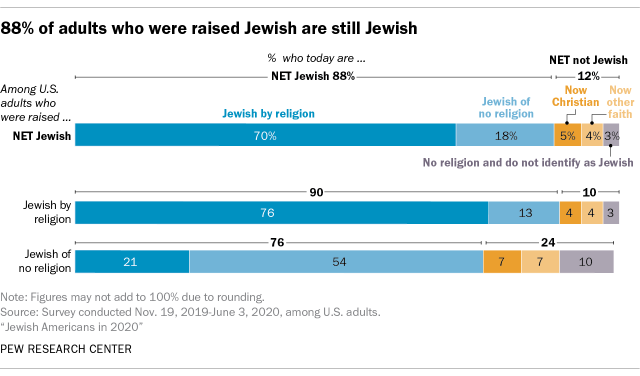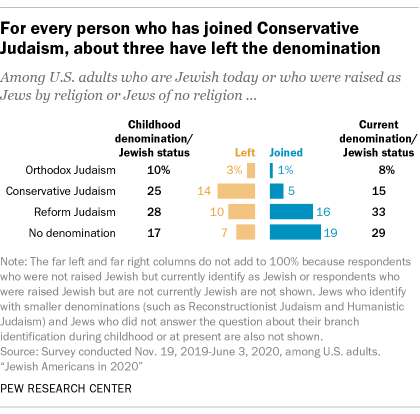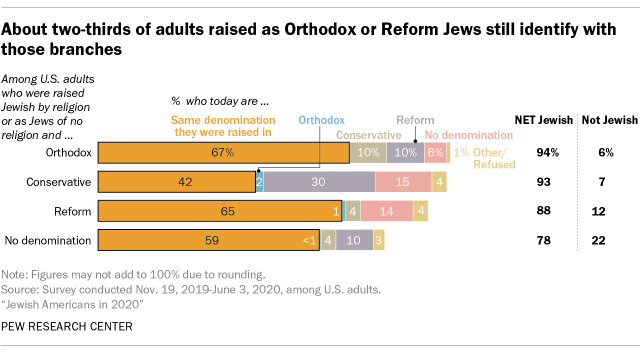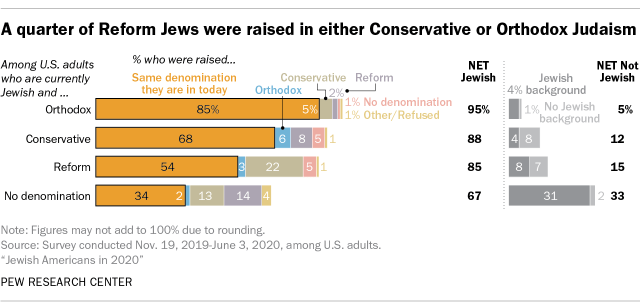The American Jewish population, like other religious groups, is in constant flux. Some people who were raised as Jews have left the religion, while some who were raised outside the faith now identify with it. Many others have switched denominations within Judaism – a trend that has seen the Reform movement grow modestly and Conservative Judaism experience a net loss, according to a recent Pew Research Center survey.
Overall, nearly nine-in-ten U.S. adults who were raised Jewish (88%) are still Jewish today. This includes 70% who identify with the Jewish religion and 18% who don’t identify with any religion but who consider themselves Jewish in some other way, such as culturally, ethnically or by family background.

On the other hand, 12% of U.S. adults who were raised as Jewish are no longer Jewish, including 5% who are now Christians.
For this analysis, Pew Research Center surveyed 5,881 U.S. adults between Nov. 19, 2019, and June 3, 2020. This includes 4,718 adults who were categorized as Jewish and 1,163 non-Jewish adults who had some sort of connection to Judaism. Respondents were drawn from a national, stratified random sample of residential mailing addresses. The survey was administered online and by mail by Westat.
All of the switching rates reported here are calculated by comparing how individual respondents describe their Jewish status and denominational affiliation today with how they say they were raised (i.e., as Jewish or not and, if raised Jewish, their childhood denominational affiliation). One key decision researchers had to make for this analysis is which set of respondents (or “base”) to use in each calculation, which differs depending on the measure. For the first and third charts shown, which are measuring retention, the base is everyone who says they were raised Jewish (but not those who are currently Jewish if they weren’t raised Jewish). For the fourth chart, which is measuring accession, the base is everyone who is currently Jewish (but not those who were raised Jewish if they’re no longer Jewish). And for the second chart, which is measuring net gain or loss through switching, the base is the combined set of everyone who was either raised Jewish or is currently Jewish.
For the purposes of these analyses, respondents are considered to have been raised Jewish only if they say Judaism was their childhood religion or if they say they were raised with no religion, that they were raised Jewish aside from religion, and they had a Jewish parent. Respondents are not considered to have been raised Jewish if they say they were raised both in another religion (e.g., Christianity) and as Jewish in some way. Nor are respondents considered to have been raised Jewish if they say they were not raised Jewish in any way – even if they also say they had a Jewish parent.
Some of the numbers presented here differ slightly from those published in the Center’s recent report on Jewish Americans in 2020 because we have made different choices about which respondents to include in the base for some calculations.
Here are the questions used for our survey of Jewish adults, along with responses, and its methodology.
The “retention rate” is higher among people who say they were brought up in the Jewish religion than it is among those who were raised as atheist, agnostic or no particular religion, but who had a Jewish parent and were raised as Jewish in some other way, such as culturally or ethnically. Nine-in-ten of these “Jews by religion” are still Jewish today, compared with 76% of those were raised as “Jews of no religion.”
How do these figures compare with the retention rates of other religious groups? We don’t have an exact apples-to-apples comparison because Jews view their identity as a matter not just of religion but also of ancestry and culture. Other U.S. religious groups, such as Protestants and Catholics, are defined in Pew Research Center surveys solely by identification with a religion. (That is why there is a “Jews of no religion” category but not a “Protestants of no religion” category, for example.)
Given this imbalance, perhaps the fairest comparison focuses on the percentage of people raised as Jews by religion who are still Jews by religion (76%). That figure is roughly on par with the retention rates among U.S. Hindus and Muslims and higher than the retention rates among evangelical Protestants and Catholics, according to the Center’s 2014 U.S. Religious Landscape Study. It’s important to note, however, that the 2014 survey was conducted by telephone, unlike the new survey of U.S. Jews, which was conducted online and by mail. Changes in survey mode can affect results.
Switching has resulted in gains for some branches of Judaism
Within Judaism, denominational switching has led to the largest net losses for the Conservative movement, which, in the 1950s and 1960s, was the largest branch of American Jewry.

In the new survey, a quarter of adults who are currently Jewish or were raised that way say they were brought up in Conservative Judaism, while 15% identify as Conservative Jews today. For every person who has joined Conservative Judaism, nearly three people who were raised in the Conservative movement have left it.
By contrast, Reform Judaism – now the largest American Jewish denomination – has experienced a net gain due to religious switching; 28% of current or former U.S. Jews say they were raised as Reform Jews, while 33% currently identify with the Reform movement.
Jews with no denominational affiliation also have experienced a net gain. About one-in-six current or former U.S. Jews (17%) say they were raised in no particular branch of Judaism, while 29% currently identify with no branch. For every person who has left this group (either to join another branch or to leave Judaism altogether), nearly three people have joined the ranks of U.S. Jews who do not affiliate with any particular Jewish denomination.
Meanwhile, one-in-ten current or former U.S. Jews say they were raised in Orthodox Judaism, and 8% currently identify as Orthodox. Despite this small net loss from denominational switching, some social scientists project that the Orthodox share of the Jewish population is likely to increase in the future, because Orthodox Jews are younger and have a higher fertility rate than non-Orthodox Jews, on average.
Orthodox and Reform Judaism have the highest retention rates
Another way of examining changes in denominational affiliation is to calculate retention rates: Among adults who were raised in a given branch of Judaism, what percentage still identify with that branch today? And where did the rest go?

Orthodox and Reform Judaism have the highest retention rates of the three major branches. Two-thirds of adults who were raised as Orthodox (67%) and Reform Jews (65%) still identify with those branches, respectively. The retention rate of Conservative Judaism is lower: About four-in-ten people raised as Conservative Jews (42%) continue to identify with Conservative Judaism as adults.
Adults who no longer identify with their childhood denomination tend to have moved in the direction of less traditional, more theologically liberal forms of Judaism – or to have left Judaism altogether – rather than in the direction of more traditional branches. For example, 57% of people raised within Conservative Judaism now either identify with Reform Judaism (30%), don’t identify with any particular branch of Judaism (15%) or are no longer Jewish (7%), while only 2% now identify with Orthodox Judaism.
Many Reform Jews were raised in more traditional branches
Yet another way of looking at denominational switching is to calculate “accession rates”: Among adults who identify with a given branch of Judaism today, what percentage were not raised in that branch, and where did they come from?

Most Orthodox Jewish adults (85%) and Conservative Jewish adults (68%) were raised in their current denomination. In other words, just 15% of today’s Orthodox Jews came from outside Orthodoxy, including 5% who were raised as Conservative and 2% who were raised as Reform. Meanwhile, about a third of today’s Conservative Jews (32%) were not raised in that movement, including 6% who were brought up as Orthodox and 8% who were raised as Reform.
The Reform movement has a somewhat higher accession rate. Nearly half (46%) of today’s Reform Jews have come from outside the Reform movement. A quarter of today’s Reform Jews were raised as either Conservative (22%) or Orthodox (3%).
The group with the highest accession rate, however, is Jews with no denominational affiliation. Two-thirds (66%) of adults in this category were raised in other groups, including 13% who were raised as Conservative Jews, 14% who were raised as Reform Jews and 33% who say they were not raised as Jewish at all (though most say they had a Jewish parent).
A relatively small proportion of respondents identify as Jewish today but say they did not have a Jewish parent and were not raised Jewish in any way. This group makes up 8% of adult Conservative Jews, 7% of Reform Jews, 2% of Jews with no denominational affiliation and 1% of Orthodox Jews. The survey did not ask whether they have gone through a formal Jewish conversion.
Note: Here are the questions used for our survey of Jewish adults, along with responses, and its methodology.





